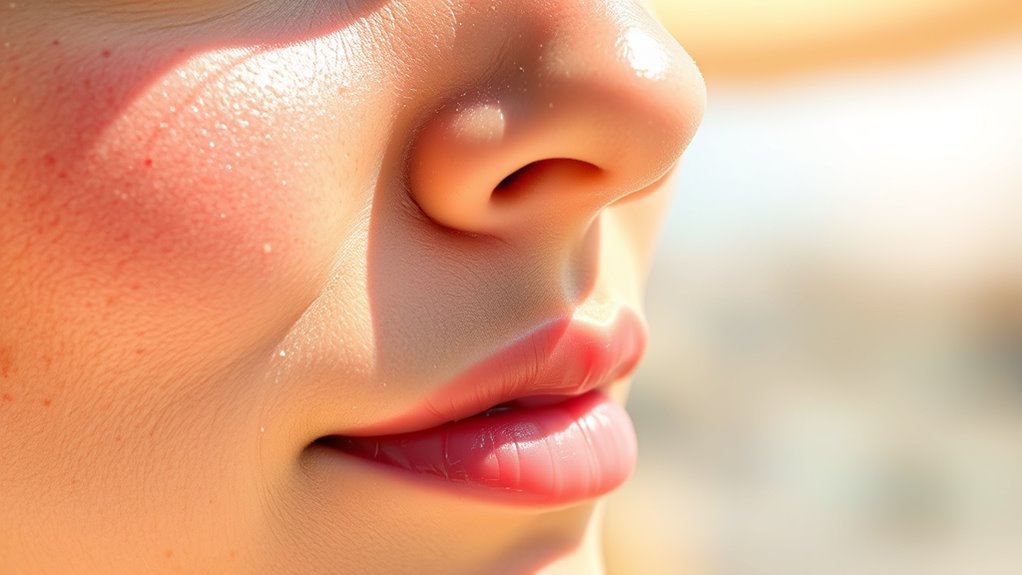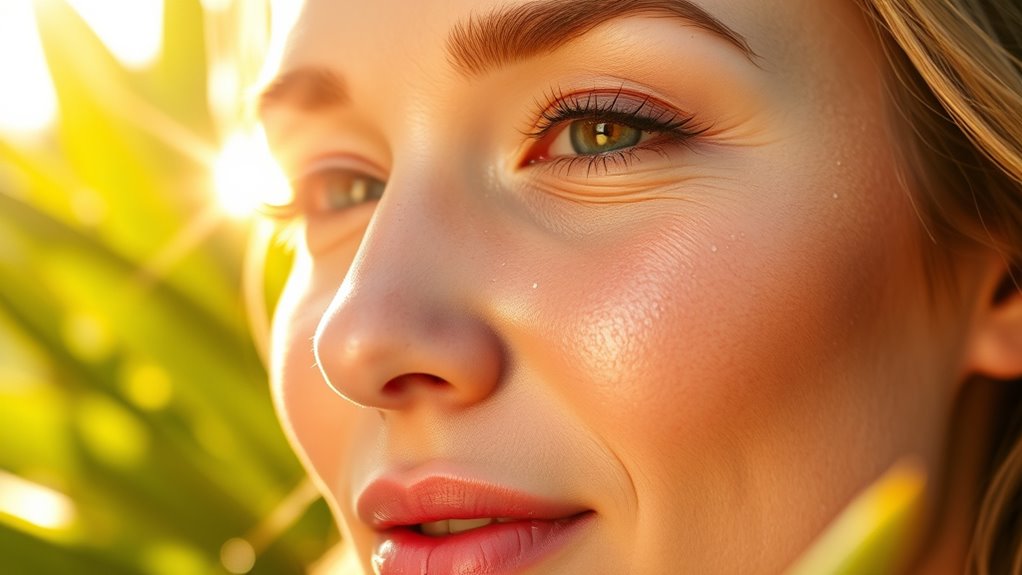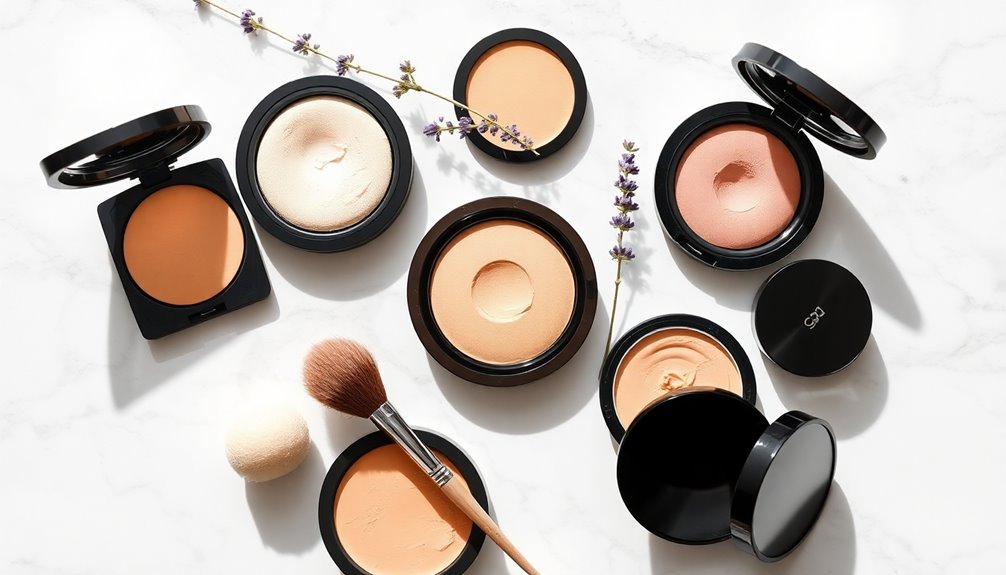To protect your skin from sun damage this summer, use a broad-spectrum sunscreen with SPF suitable for your skin type, applying it generously 15 minutes before going outside and reapplying every two hours. Wear protective clothing, like wide-brimmed hats and UV-blocking sunglasses, especially during peak hours between 10 a.m. and 4 p.m. Incorporate antioxidants in your skincare routine and seek shade during midday. Keep your skin healthy and resilient by following these tips—more insights await to help you stay safe.
Key Takeaways
- Use broad-spectrum sunscreen with at least SPF 30 and reapply every two hours during outdoor activities.
- Wear protective clothing, wide-brimmed hats, and UV-blocking sunglasses to shield skin from harmful rays.
- Schedule outdoor activities outside peak sun hours (10 a.m. – 4 p.m.) and seek shade whenever possible.
- Incorporate antioxidant-rich serums and water-based products to repair and hydrate sun-damaged skin.
- Maintain a healthy lifestyle with a balanced diet, hydration, and sun safety routines to support long-term skin health.
Understanding the Impact of Sun Damage on Your Skin

Since sun damage accumulates over time, understanding its effects on your skin is essential for maintaining a healthy complexion. UV rays penetrate deep into your skin, breaking down collagen and elastin, which are crucial for firmness and elasticity. This degradation accelerates the formation of wrinkles, fine lines, and sagging, contributing to premature aging signs. Sun exposure also causes pigmentation issues such as dark spots and uneven skin tone. Over time, UV damage can increase your risk of skin cancer, including melanoma. Even if you don’t see immediate effects, repeated exposure silently damages your skin cells, weakening their structure. Recognizing these impacts helps you appreciate the importance of sun protection. Being proactive now can prevent long-term skin issues and keep your complexion vibrant and youthful for years to come. Additionally, incorporating water-based skincare products can help hydrate and repair sun-damaged skin effectively, especially when combined with other sun protection measures. Regular use of antioxidant-rich serums can also help neutralize free radicals caused by UV exposure and further protect your skin from damage. Moreover, understanding personality traits such as resilience and adaptability can motivate you to maintain consistent sun safety habits, especially during challenging weather conditions. Consulting with a dermatologist about personalized skincare routines can enhance your defense against sun-induced aging.
Choosing the Right Sunscreen for Your Skin Type

Choosing the right sunscreen for your skin type is essential to effectively protect your skin without causing irritation or breakouts. If you have sensitive skin, look for sunscreens labeled “hypoallergenic” or “for sensitive skin,” and avoid fragrances or alcohol that can cause irritation. If your skin is oily or acne-prone, opt for oil-free, non-comedogenic formulas that won’t clog pores. For dry skin, choose sunscreens with moisturizing ingredients like hyaluronic acid or glycerin. Those with darker skin tones should still wear sunscreen daily, but may prefer formulas with added antioxidants or tinted sunscreens that blend seamlessly without leaving a white cast. Always check the SPF and broad-spectrum protection to make sure you’re blocking both UVA and UVB rays effectively. Additionally, understanding the different cookie categories used by websites can help you manage your online privacy while researching skincare products. Incorporating sun protection habits such as wearing hats and seeking shade can further enhance your skin’s defense against sun damage. To better understand how to choose the best products, investing in personal finance literacy can help you make informed decisions about skincare budgets and investments. Moreover, some hackathons focus on developing innovative sun protection solutions, which can be a valuable resource for discovering new products and technologies. Being aware of product formulations can also guide you in selecting sunscreens that suit your specific needs and avoid potential irritants.
The Importance of Applying Sunscreen Correctly and Frequently

Applying sunscreen correctly and regularly guarantees your skin stays protected throughout the day. To do this effectively, follow these steps: 1. Apply a generous amount of sunscreen 15 minutes before sun exposure. 2. Reapply every two hours, or immediately after swimming or sweating. 3. Cover all exposed skin, including easy-to-forget areas like ears, neck, and the tops of your feet. Proper application and consistent reapplication ensure optimal protection. Using the right amount assures you get the full SPF protection. Don’t skip reapplication, especially during prolonged outdoor activities. Remember, sunscreen isn’t a one-and-done step; it’s an ongoing process to keep your skin shielded. Regular reapplication is essential because sun exposure can diminish the effectiveness of sunscreen over time. Proper application reduces the risk of sunburn, skin damage, and long-term aging. Ensuring your sunscreen has an adequate shelf life can further optimize your protection. Consistency is key to enjoying your time outside while safeguarding your skin.
Protective Clothing and Accessories to Block Harmful Rays

Wearing protective clothing and accessories can make a big difference in blocking harmful rays. A wide-brimmed hat shields your face and neck, while UV-protective sunglasses guard your eyes. Incorporating these items into your summer routine helps keep your skin safe from sun damage. Practicing protective measures can also reduce the risk of long-term skin issues caused by sun exposure. Choosing appropriate clothing made from breathable, UV-resistant fabrics can further enhance your protection during outdoor activities.
Wide-brimmed Hats
Wide-brimmed hats are a simple yet effective way to shield your face, neck, and shoulders from the sun’s harmful rays. They provide broad coverage, reducing your risk of sunburn and long-term skin damage. When choosing a hat, look for one with a brim at least 3 inches wide to maximize protection. Consider these options to enhance your sun defense:
- Material: Opt for tightly woven fabrics like canvas or straw that block UV rays.
- Color: Darker shades absorb more UV radiation, offering better protection.
- Fit: Ensure the hat fits comfortably and stays in place even on windy days.
Wearing a wide-brimmed hat is an easy, stylish way to stay protected during outdoor activities while keeping your skin safe from sun damage.
UV-protective Sunglasses
Since your eyes and skin are vulnerable to the sun’s harmful rays, UV-protective sunglasses are an essential accessory for summer. They block out 99% to 100% of UVA and UVB rays, reducing your risk of eye damage and skin cancer around your eyes. Look for sunglasses labeled with UV protection or UV400, which indicates full protection. Choose larger frames or wraparound styles to minimize rays sneaking in from the sides. Wearing sunglasses also helps prevent eye strain and long-term issues like cataracts. Remember, even on cloudy days, UV rays can reach your eyes, so keep your sunglasses handy. Incorporating UV-protective sunglasses into your summer routine is a simple, effective way to safeguard your vision and skin. Proper eye protection is vital because prolonged UV exposure can contribute to long-term eye health issues. Additionally, choosing sunglasses with UV protection can enhance your overall safety during outdoor activities. Using UV filters in sunglasses ensures maximum protection from harmful rays and can prevent potential damage over time.
Furthermore, selecting sunglasses with appropriate coverage can help block stray rays from entering from different angles, providing comprehensive protection.
The Role of Skincare Ingredients in Sun Protection

Skincare ingredients play a crucial role in providing effective sun protection by either blocking or absorbing harmful ultraviolet (UV) rays. Ingredients like zinc oxide and titanium dioxide create a physical barrier on your skin, reflecting UV radiation away. Chemical filters such as avobenzone, oxybenzone, and octocrylen e absorb UV rays, converting them into harmless heat. Additionally, the contrast ratio of a projector can significantly influence how well these details are perceived on-screen, especially in scenes with varying light levels. Understanding the material durability of sunscreen ingredients ensures long-lasting protection during prolonged sun exposure. The integration of automation in manufacturing processes can also help produce more consistent and reliable sunscreen formulations. When selecting products, considering the dog breed can help determine the most suitable type of sunscreen, as some breeds may have more sensitive skin. Research shows that formulation stability is essential to maintain the efficacy of sunscreen ingredients over time, especially when exposed to heat and sunlight. To understand how these ingredients work, consider:
Effective sun protection relies on ingredients that block or absorb UV rays, like zinc oxide and chemical filters.
- Zinc oxide forms a white, protective shield that blocks UVA and UVB rays effectively.
- Chemical filters penetrate your skin to absorb and neutralize UV radiation.
- Some products combine physical and chemical filters for broad-spectrum protection.
Timing Your Outdoor Activities to Minimize Sun Exposure

To protect your skin, plan outdoor activities outside peak sun hours, typically between 10 a.m. and 4 p.m. Consider doing errands or exercising early in the morning or later in the evening when the sun is less intense. Taking shade breaks and seeking cover in shaded areas can also considerably reduce your sun exposure during peak times. Practicing mindful attention during outdoor activities further enhances your sun safety. Incorporating sun protection measures such as wearing wide-brimmed hats and UV-protective clothing can provide additional defense against harmful rays. Using appropriate skincare products with SPF can further bolster your skin’s protection during extended outdoor exposure. Additionally, understanding the importance of mental wellbeing can help you maintain a balanced approach to sun safety and overall health during the summer months.
Peak Sun Hours
Have you ever wondered when the sun’s rays are the strongest? Typically, peak sun hours occur between 10 a.m. and 4 p.m., when UV radiation is most intense. During this time, your skin faces the highest risk of damage. To minimize exposure, consider these tips:
- Plan outdoor activities early in the morning or late in the afternoon.
- Seek shade during the midday hours, especially between 12 p.m. and 2 p.m.
- Wear protective clothing, hats, and sunglasses to shield your skin from direct sunlight.
Morning and Evening Care
Since the sun is less intense during early morning and late evening, these times are ideal for outdoor activities. Planning your walks, workouts, or errands during these hours helps you avoid peak UV exposure, reducing your risk of sun damage. Use this time to enjoy outdoor chores or exercise, but remember to still wear a broad-spectrum sunscreen if you’ll be outside for extended periods. In the morning, cleanse your skin to remove sweat and impurities from the night, then apply moisturizer and sunscreen. In the evening, focus on gentle cleansing to wash away dirt, sweat, and sunscreen residue. Incorporating these routines helps maintain healthy skin while minimizing sun exposure’s harmful effects. Adjust your schedule to prioritize outdoor activities during safer times for *excellent* summer skincare.
Shade Breaks Strategies
Timing your outdoor activities around shade breaks can substantially reduce your sun exposure and protect your skin. To maximize this, plan your day with these steps:
- Start early or late: Schedule outdoor tasks during early morning or late afternoon when the sun’s rays are weaker.
- Seek shade regularly: Take breaks under trees, awnings, or umbrellas every 30-60 minutes.
- Limit midday exposure: Avoid outdoor activities between 10 a.m. and 4 p.m., when UV radiation peaks.
Daily Skincare Routines to Repair and Rejuvenate Sun-Damaged Skin

To effectively repair and rejuvenate sun-damaged skin, establishing a consistent daily skincare routine is essential. Start with gentle cleansing to remove pollutants and excess oil. Follow with a nourishing serum packed with antioxidants like vitamin C to brighten your skin and combat free radicals. Use a rich moisturizer to restore hydration and support skin repair. Don’t forget to apply a broad-spectrum SPF every morning, even on cloudy days, to prevent further damage.
Picture this routine:
| Morning Routine | Evening Routine |
|---|---|
| Cleanse and apply antioxidant serum | Cleanse again, then apply reparative moisturizer |
| Sunscreen for protection | Use targeted treatments like retinoids |
Lifestyle Habits for Long-Term Skin Health and Protection

Adopting healthy lifestyle habits plays a crucial role in maintaining long-term skin health and protecting against future sun damage. Your daily choices can markedly impact your skin’s resilience and appearance over time. First, prioritize a balanced diet rich in antioxidants, vitamins, and minerals to support skin repair from within. Second, stay consistently hydrated to keep your skin supple and better equipped to recover from sun exposure. Third, incorporate regular exercise to boost circulation, which helps deliver nutrients and oxygen to your skin cells. Additionally, avoid smoking and limit alcohol intake, as these habits accelerate skin aging and diminish its protective barrier. By making these simple yet effective lifestyle adjustments, you strengthen your skin’s natural defenses, ensuring it stays healthier and better protected against sun damage in the long run.
Frequently Asked Questions
How Does UV Exposure Affect Different Skin Tones?
You might wonder how UV exposure impacts various skin tones. Lighter skin burns more quickly and shows damage visibly, but darker skin isn’t immune; it still sustains sun damage and risks hyperpigmentation. You need to understand that UV rays penetrate all skin types, so regardless of your tone, wearing sunscreen, seeking shade, and protecting your skin is essential. This proactive approach keeps your skin healthy and reduces long-term damage.
Can Certain Foods Enhance Natural Sun Protection?
Many believe certain foods boost your natural sun protection, but science isn’t conclusive. However, eating antioxidant-rich foods like berries, nuts, and vegetables can help your skin defend against UV damage by reducing inflammation and repairing cells. While they shouldn’t replace sunscreen, these foods support overall skin health. So, enjoy a colorful diet year-round to strengthen your skin’s resilience and complement your sun protection routine.
Are There Natural or Organic Sunscreens Effective Enough?
You wonder if natural or organic sunscreens work well enough. While some organic options contain mineral blockers like zinc oxide or titanium dioxide, they can offer effective protection if applied properly and frequently. However, they might not be as long-lasting or broad-spectrum as conventional sunscreens. To stay protected, choose reputable brands, reapply often, and combine with other sun safety measures like seeking shade and wearing protective clothing.
How Often Should I Replace My Sunscreen?
Imagine your sunscreen as a shield that weakens over time. You should replace it every year, especially if it’s been exposed to heat or sunlight, which can break down its effectiveness. Check the expiration date on the bottle—most sunscreens last about 2-3 years. If the formula looks or smells different, discard it. Regularly replacing your sunscreen ensures you stay protected under the sun’s relentless rays.
Can Sunscreen Cause Vitamin D Deficiency?
You might wonder if sunscreen causes vitamin D deficiency. While sunscreen blocks UVB rays needed for vitamin D production, it’s unlikely you’ll become deficient if you use it regularly. Just a few minutes of sun exposure each day, without sunscreen, can help your body produce enough vitamin D. Prioritize sunscreen to protect your skin, but also seek safe sun exposure or consider supplements if you’re concerned about deficiency.
Conclusion
Protecting your skin is like shielding a delicate treasure—your health and youthful glow. By choosing the right sunscreen, dressing smartly, and staying mindful of sun exposure, you can enjoy summer without worry. Incorporate proper skincare routines and healthy habits to repair and strengthen your skin over time. Remember, small daily efforts build a shield against sun damage, keeping your skin radiant and resilient, just like a fortress standing strong against the sun’s relentless rays.










